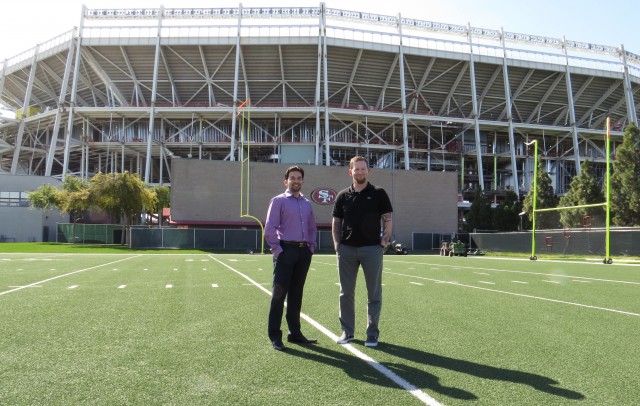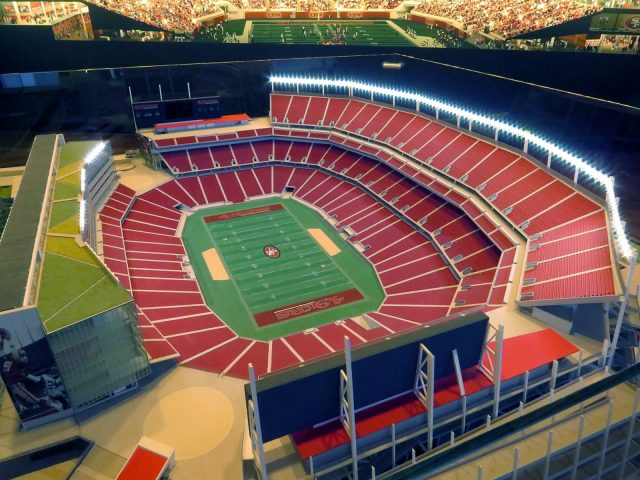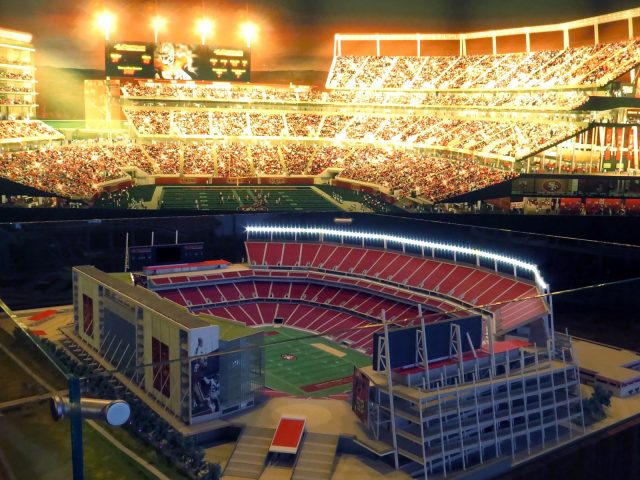
When the San Francisco 49ers' new stadium opens for the 2014 NFL season, it is quite likely to have the best publicly accessible Wi-Fi network a sports facility in this country has ever known.
The 49ers are defending NFC champions, so 68,500 fans will inevitably walk into the stadium for each game. And every single one of them will be able to connect to the wireless network, simultaneously, without any limits on uploads or downloads. Smartphones and tablets will run into the limits of their own hardware long before they hit the limits of the 49ers' wireless network.


Until now, stadium executives have said it's pretty much impossible to build a network that lets every single fan connect at once. They've blamed this on limits in the amount of spectrum available to Wi-Fi, despite their big budgets and the extremely sophisticated networking equipment that largesse allows them to purchase. Even if you build the network perfectly, it would choke if every fan tried to get on at once—at least according to conventional wisdom.
But the people building the 49ers' wireless network do not have conventional sports technology backgrounds. Senior IT Director Dan Williams and team CTO Kunal Malik hail from Facebook, where they spent five years building one of the world's largest and most efficient networks for the website. The same sensibilities that power large Internet businesses and content providers permeate Williams' and Malik's plan for Santa Clara Stadium, the 49ers' nearly half-finished new home.
"We see the stadium as a large data center," Williams told me when I visited the team's new digs in Santa Clara.

I had previously interviewed Williams and Malik over the phone, and that's when they first told me they planned to make Wi-Fi so ubiquitous throughout the stadium that everyone could get on at once. I had never heard of such an ambitious plan before—how could this be possible?
Today’s networks are impressive—but not unlimited
An expansive Wi-Fi network at this year's Super Bowl in the New Orleans Superdome was installed to allow as many as 30,000 fans to get online at once. This offloaded traffic from congested cellular networks and gave fans the ability to view streaming video or do other bandwidth-intensive tasks meant to enhance the in-game experience. (Don't scoff—as we've noted before, three-plus-hour NFL games contain only 11 minutes of actual game action, or a bit more if you include the time quarterbacks spend shouting directions at teammates at the line of scrimmage. There is plenty of time to fill up.)
Superdome officials felt a network allowing 30,000 simultaneous connections would be just fine, given that the previous year's Super Bowl saw only 8,260 at its peak. They were generally right, as the network performed well, even for part of the game's power outage.
The New England Patriots installed a full-stadium Wi-Fi network this past season as well. It was never used by more than 10,000 or so people simultaneously, or by more than 16,000 people over the course of a full game. "Can 70,000 people get on the network at once? The answer to that is no," said John Brams, director of hospitality and venues at the Patriots' network vendor, Enterasys. "If everyone tried to do it all at once, that's probably not going to happen."
But as more fans bring smart devices into stadiums, activities like viewing instant replays or live camera angles available only to ticket holders will become increasingly common. It'll put more people on the network at once and require bigger wireless pipes. So if Williams and Malik have their way, every single 49ers ticket holder will enjoy a wireless connection faster than any wide receiver sprinting toward the end zone.
"Is it really possible to give Wi-Fi to 68,500 fans at once?" I asked. I expected some hemming and hawing about how the 49ers will do their best and that not everyone will ever try to use the network at once anyway.

"Yes. We can support all 68,500," Williams said emphatically.
How?
"How not?" he answered.
Won't you have to limit the capacity each fan can get?
Again, absolutely not. "Within the stadium itself, there will probably be a terabit of capacity. The 68,500 will not be able to penetrate that. Our intentions in terms of Wi-Fi are to be able to provide a similar experience that you would receive with LTE services, which today is anywhere from 20 to 40 megabits per second, per user.
"The goal is to provide you with enough bandwidth that you would saturate your device before you saturate the network," Williams said. "That's what we expect to do."
Fans won't be limited by what section they're in, either. If the 49ers offer an app that allows fans to order food from their seats, or if they offer a live video streaming app, they'll be available to all fans.

"The mobile experience should not be limited to, 'Hey, because you sit in a club seat you can see a replay, but because you don't sit in a club seat you can't see a replay,'" Malik said. "That's not our philosophy. Our philosophy is to provide enhancement of the game experience to every fan." (The one exception would be mobile features designed specifically for physical features of luxury boxes or club seats that aren't available elsewhere in the stadium.)
It’s the design that counts
Current stadium Wi-Fi designs, even with hundreds of wireless access points distributed throughout a stadium, often can support only a quarter to a half of fans at once. They also often limit bandwidth for each user to prevent network slowdowns.
The Patriots offer fans a live video and instant replay app, with enough bandwidth to access video streams, upload photos to social networks, and use the Internet in general. Enterasys confirmed to Ars that the Patriots do enforce a bandwidth cap to prevent individual users from overloading the network, but Enterasys would not say exactly how big the cap is. The network has generally been a success, but some users of the Patriots app have taken to the Android app store to complain about the stadium Wi-Fi's performance.
According to Williams, most current stadium networks are limited by a fundamental problem: sub-optimal location of wireless access points.
"A typical layout is overhead, one [access point] in front of the section, one behind the section, and they point towards each other," he said. "This overhead design is widely used and provides enough coverage for those using the design."
Williams would not reveal the exact layout of the 49ers' design, perhaps to prevent the competition from catching on. How many access points will there be? "Zero to 1,500," he said in a good-natured attempt to be both informative and vague.
That potentially doubles or quadruples the typical amount of stadium access points—the Super Bowl had 700 and the Patriots have 375. But this number isn't the most important thing. "The number of access points will not give you any hint on whether the Wi-Fi is going to be great or not," Malik said. "Other factors control that."
reader comments
96